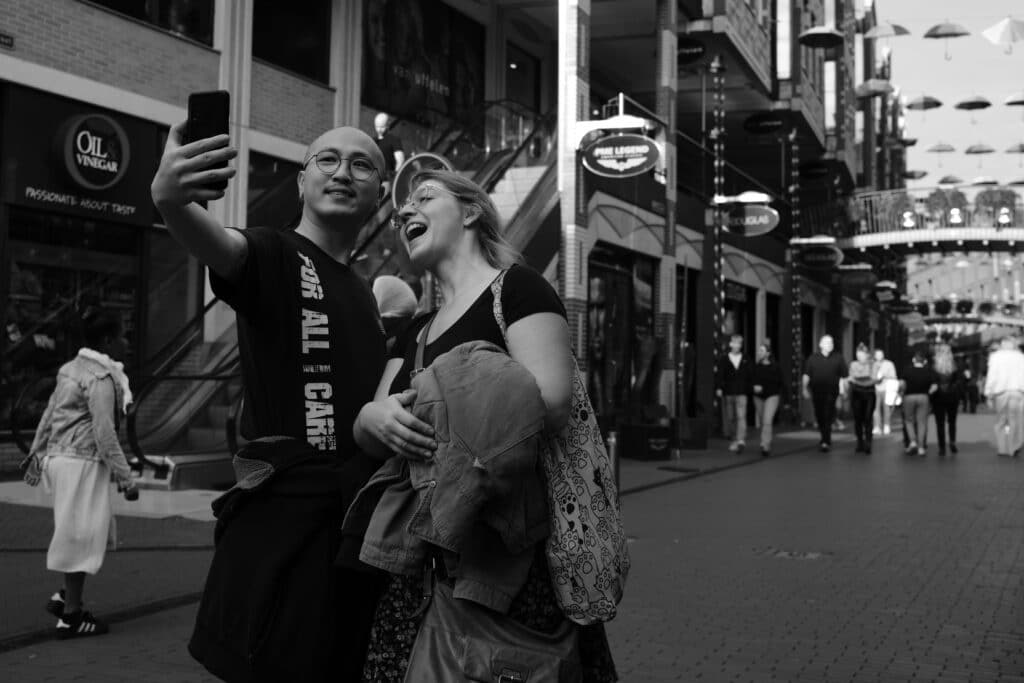The history of street photography dates back to the invention of the camera. But it was only in the 20th century that the genre really developed into an art form.
Origins of street photography

The origins of street photography can be traced back to the early 20th century, when photography enthusiasts began experimenting with capturing urban life. One of the first well-known street photographers was Eugène Atget, who worked in Paris in the early 20th century. Atget was known for his images of the streets and architecture of Paris and is often considered the father of street photography.
In the 1930s and 1940s, Henri Cartier-Bresson began photographing the world. He was one of the founding fathers of photojournalism and known for his ability to capture decisive moments. Cartier-Bresson was also a pioneer of street photography and is known for his images of everyday life in cities around the world.
Smaller cameras = more street photographers
After World War II, street photography became increasingly popular and began to develop as an art form. Photographers such as Robert Frank and Garry Winogrand were famous for their depictions of American life in the 1950s and 1960s. In the 1970s and 1980s, street photography developed even further and new styles and techniques were introduced. Important in this, of course, was the development of an ever-smaller camera. Lugging a tripod and more was suddenly no longer necessary.
For me, this is the most interesting period. Let's face it: we all love those gentlemen in top hats and the hoes on the street corner. It is not melancholy, but simply a lovely black-and-white picture to look at. It brings to mind old movies, slapstick, and yet also a bit of times when people seemed to be more carefree. When smoking was healthy, so to speak.
From black and white to colour
One of the most important street photographers of this period was Alex Webb. Webb was best known for his colour photos and his ability to create complex images with multiple layers. He travelled the world taking photographs and was known for his depictions of Latin America and the Caribbean. Webb's work has often been compared to that of painters because of the rich colours and layering of his images.
In the 1990s and 2000s, street photography was increasingly recognised as an important art form and began to reach a wider audience. Photographers such as Martin Parr and Bruce Gilden were known for their satirical and sometimes provocative images of modern life. New styles of street photography also emerged, including "vernacular photography", in which photographers focused on capturing the unintended beauty of everyday objects and scenes.
Digital photography and social media are changing street photography

The rise of digital photography and social media has further changed and expanded street photography. Photographers can now easily share their work and receive feedback from a global audience. This has led to a greater diversity of styles and approaches to street photography.
In recent years, street photography has evolved and expanded, with more emphasis on themes of urban change, migration, identity and politics. Street photographers such as Daido Moriyama and Trent Parke, for example, have pushed the boundaries of street photography with their experimental techniques and abstract images. Valérie Jardin talks about contemplative photography, and I really like that term. Photograph what you feel, not necessarily just what you see. It offers a lot of room for your own interpretation.
Criticism of street photography
At the same time, street photography has also been criticised as a genre that too often focuses on photographing vulnerable or marginal groups without their consent or knowledge. Some photographers and critics argue for a more ethical approach to street photography, with respect for the privacy and dignity of those portrayed at its core. The advent of the AVG and more privacy legislation have also put street photography under a microscope, unfairly in my view.
Nevertheless, street photography remains a powerful and influential art form that can help us better understand the world around us and explore our relationship with the urban environment. The pioneers of street photography, such as Atget, Cartier-Bresson and Webb, helped us see the potential of this art form and paved the way for the many talented street photographers who have followed them.